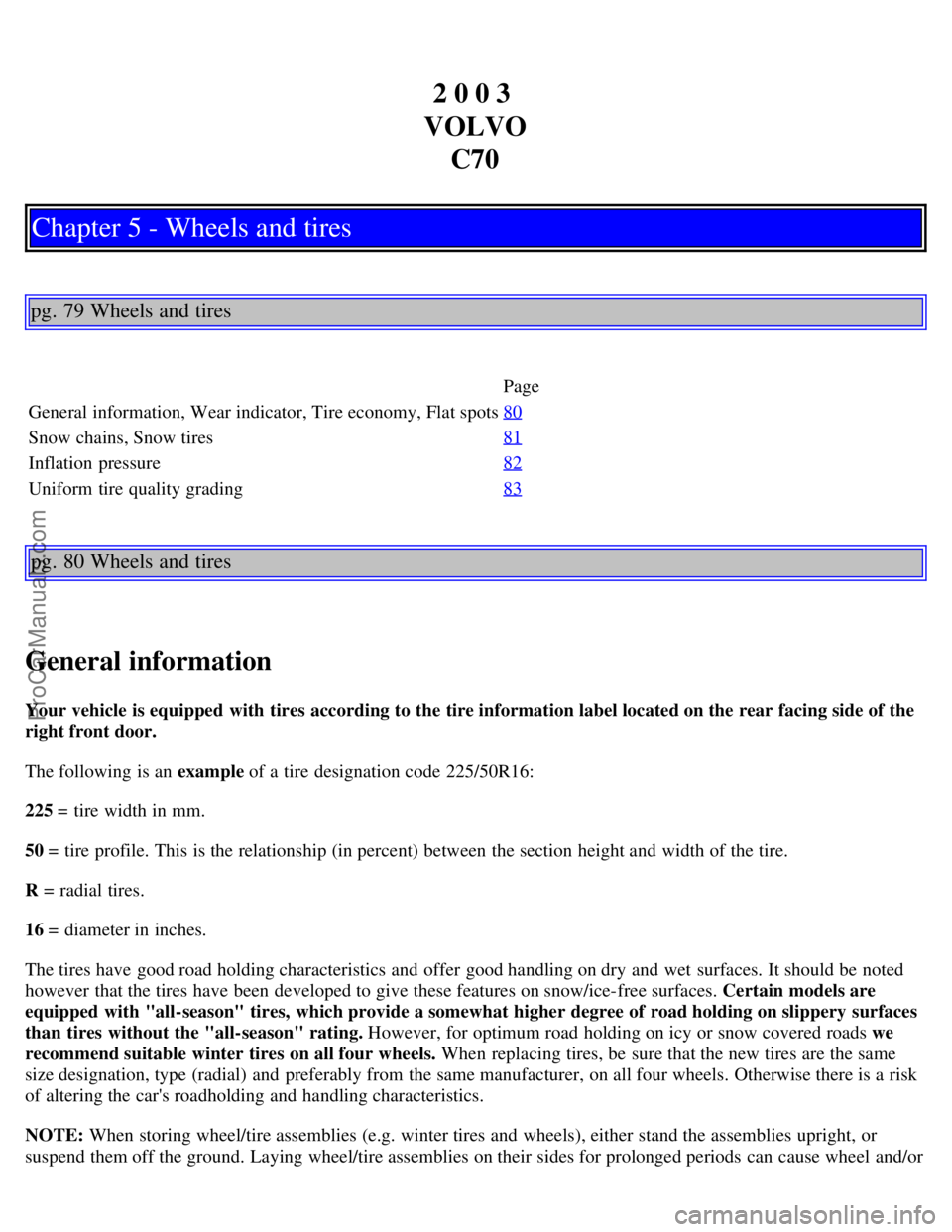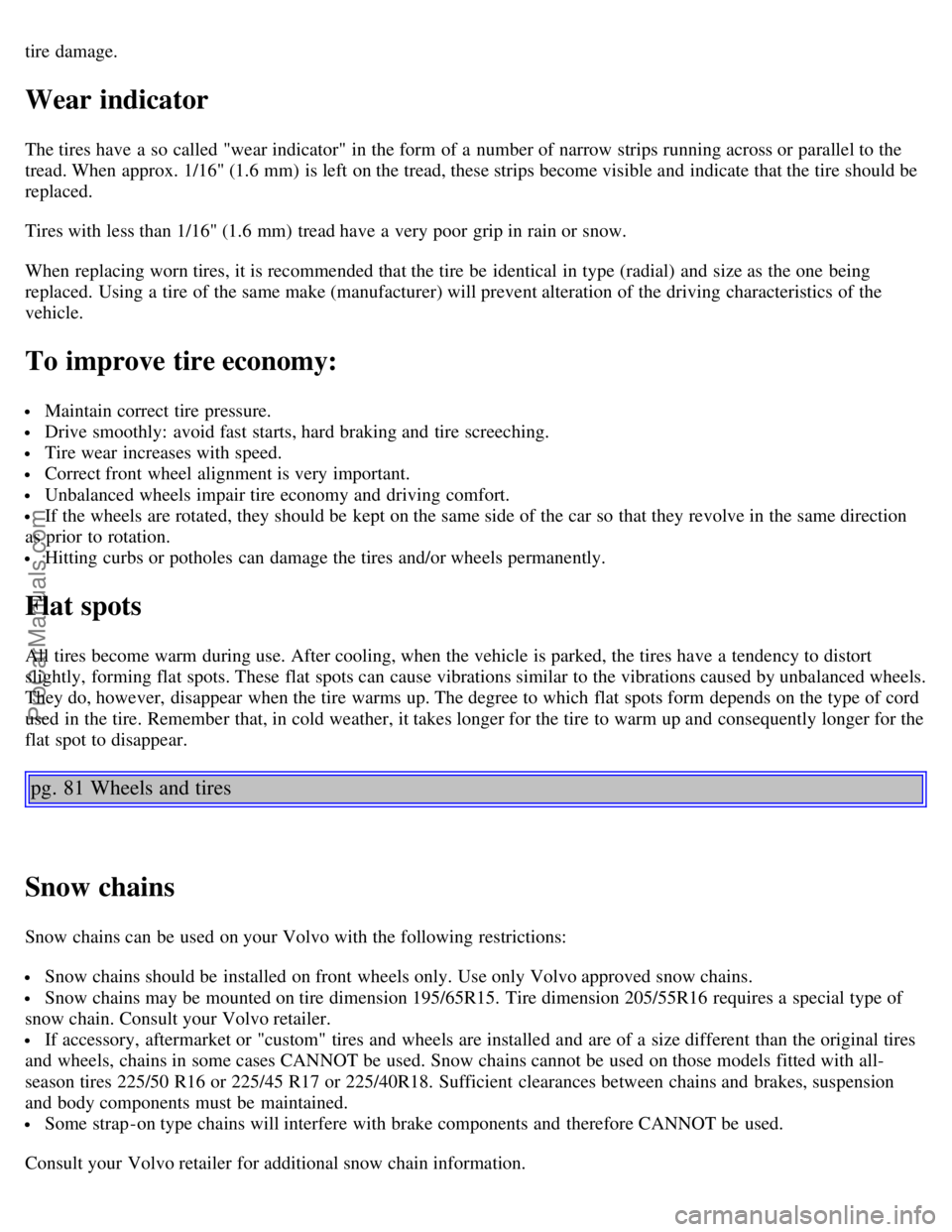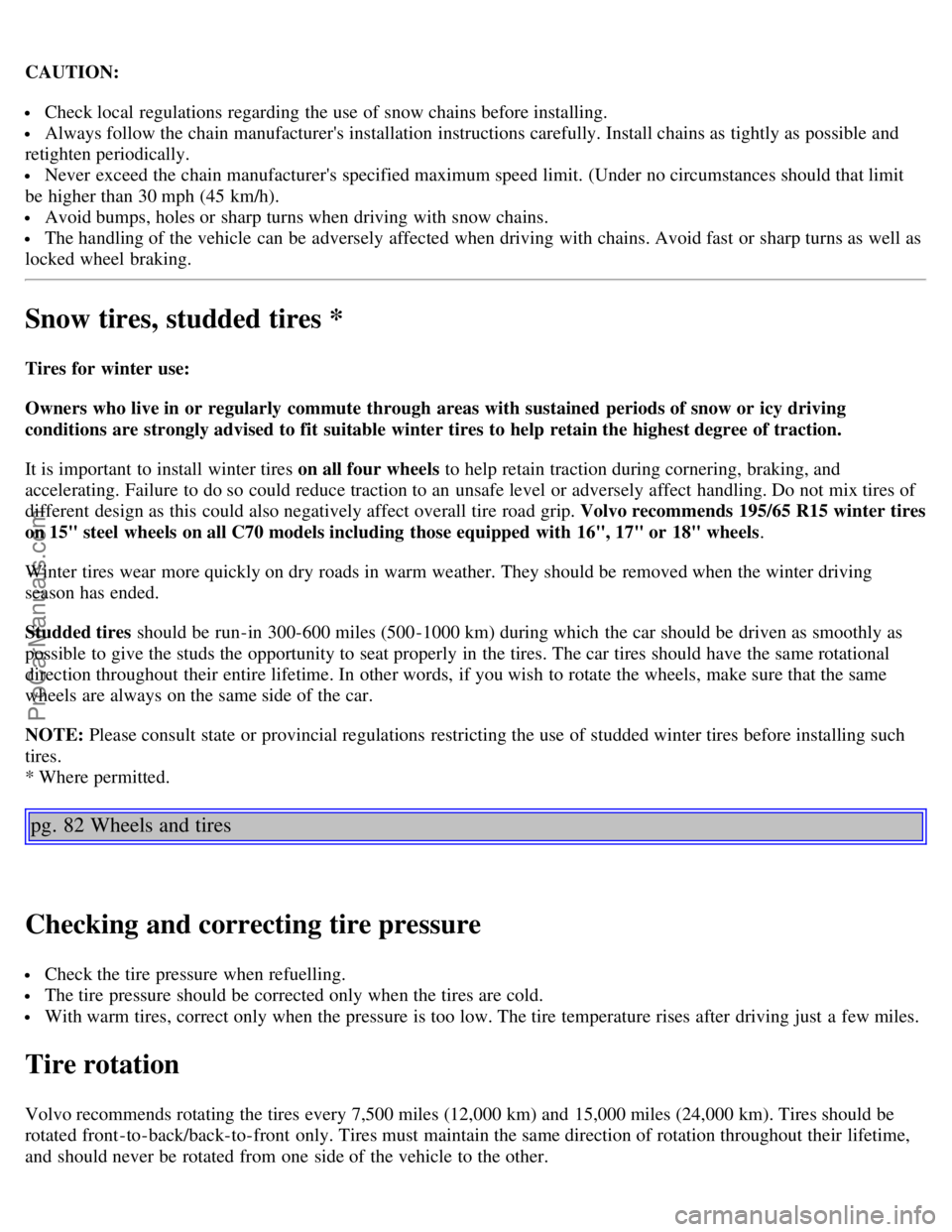snow chains VOLVO C70 2003 Owners Manual
[x] Cancel search | Manufacturer: VOLVO, Model Year: 2003, Model line: C70, Model: VOLVO C70 2003Pages: 98, PDF Size: 1.64 MB
Page 44 of 98

2 0 0 3
VOLVO C70
Chapter 5 - Wheels and tires
pg. 79 Wheels and tires
Page
General information, Wear indicator, Tire economy, Flat spots 80
Snow chains, Snow tires81
Inflation pressure82
Uniform tire quality grading83
pg. 80 Wheels and tires
General information
Your vehicle is equipped with tires according to the tire information label located on the rear facing side of the
right front door.
The following is an example of a tire designation code 225/50R16:
225 = tire width in mm.
50 = tire profile. This is the relationship (in percent) between the section height and width of the tire.
R = radial tires.
16 = diameter in inches.
The tires have good road holding characteristics and offer good handling on dry and wet surfaces. It should be noted
however that the tires have been developed to give these features on snow/ice-free surfaces. Certain models are
equipped with "all-season" tires, which provide a somewhat higher degree of road holding on slippery surfaces
than tires without the "all-season" rating. However, for optimum road holding on icy or snow covered roads we
recommend suitable winter tires on all four wheels. When replacing tires, be sure that the new tires are the same
size designation, type (radial) and preferably from the same manufacturer, on all four wheels. Otherwise there is a risk
of altering the car's roadholding and handling characteristics.
NOTE: When storing wheel/tire assemblies (e.g. winter tires and wheels), either stand the assemblies upright, or
suspend them off the ground. Laying wheel/tire assemblies on their sides for prolonged periods can cause wheel and/or
ProCarManuals.com
Page 45 of 98

tire damage.
Wear indicator
The tires have a so called "wear indicator" in the form of a number of narrow strips running across or parallel to the
tread. When approx. 1/16" (1.6 mm) is left on the tread, these strips become visible and indicate that the tire should be
replaced.
Tires with less than 1/16" (1.6 mm) tread have a very poor grip in rain or snow.
When replacing worn tires, it is recommended that the tire be identical in type (radial) and size as the one being
replaced. Using a tire of the same make (manufacturer) will prevent alteration of the driving characteristics of the
vehicle.
To improve tire economy:
Maintain correct tire pressure.
Drive smoothly: avoid fast starts, hard braking and tire screeching.
Tire wear increases with speed.
Correct front wheel alignment is very important.
Unbalanced wheels impair tire economy and driving comfort.
If the wheels are rotated, they should be kept on the same side of the car so that they revolve in the same direction
as prior to rotation.
Hitting curbs or potholes can damage the tires and/or wheels permanently.
Flat spots
All tires become warm during use. After cooling, when the vehicle is parked, the tires have a tendency to distort
slightly, forming flat spots. These flat spots can cause vibrations similar to the vibrations caused by unbalanced wheels.
They do, however, disappear when the tire warms up. The degree to which flat spots form depends on the type of cord
used in the tire. Remember that, in cold weather, it takes longer for the tire to warm up and consequently longer for the
flat spot to disappear.
pg. 81 Wheels and tires
Snow chains
Snow chains can be used on your Volvo with the following restrictions:
Snow chains should be installed on front wheels only. Use only Volvo approved snow chains.
Snow chains may be mounted on tire dimension 195/65R15. Tire dimension 205/55R16 requires a special type of
snow chain. Consult your Volvo retailer.
If accessory, aftermarket or "custom" tires and wheels are installed and are of a size different than the original tires
and wheels, chains in some cases CANNOT be used. Snow chains cannot be used on those models fitted with all-
season tires 225/50 R16 or 225/45 R17 or 225/40R18. Sufficient clearances between chains and brakes, suspension
and body components must be maintained.
Some strap -on type chains will interfere with brake components and therefore CANNOT be used.
Consult your Volvo retailer for additional snow chain information.
ProCarManuals.com
Page 46 of 98

CAUTION:
Check local regulations regarding the use of snow chains before installing.
Always follow the chain manufacturer's installation instructions carefully. Install chains as tightly as possible and
retighten periodically.
Never exceed the chain manufacturer's specified maximum speed limit. (Under no circumstances should that limit
be higher than 30 mph (45 km/h).
Avoid bumps, holes or sharp turns when driving with snow chains.
The handling of the vehicle can be adversely affected when driving with chains. Avoid fast or sharp turns as well as
locked wheel braking.
Snow tires, studded tires *
Tires for winter use:
Owners who live in or regularly commute through areas with sustained periods of snow or icy driving
conditions are strongly advised to fit suitable winter tires to help retain the highest degree of traction.
It is important to install winter tires on all four wheels to help retain traction during cornering, braking, and
accelerating. Failure to do so could reduce traction to an unsafe level or adversely affect handling. Do not mix tires of
different design as this could also negatively affect overall tire road grip. Volvo recommends 195/65 R15 winter tires
on 15" steel wheels on all C70 models including those equipped with 16", 17" or 18" wheels .
Winter tires wear more quickly on dry roads in warm weather. They should be removed when the winter driving
season has ended.
Studded tires should be run-in 300-600 miles (500-1000 km) during which the car should be driven as smoothly as
possible to give the studs the opportunity to seat properly in the tires. The car tires should have the same rotational
direction throughout their entire lifetime. In other words, if you wish to rotate the wheels, make sure that the same
wheels are always on the same side of the car.
NOTE: Please consult state or provincial regulations restricting the use of studded winter tires before installing such
tires.
* Where permitted.
pg. 82 Wheels and tires
Checking and correcting tire pressure
Check the tire pressure when refuelling.
The tire pressure should be corrected only when the tires are cold.
With warm tires, correct only when the pressure is too low. The tire temperature rises after driving just a few miles.
Tire rotation
Volvo recommends rotating the tires every 7,500 miles (12,000 km) and 15,000 miles (24,000 km). Tires should be
rotated front -to-back/back-to-front only. Tires must maintain the same direction of rotation throughout their lifetime,
and should never be rotated from one side of the vehicle to the other.
ProCarManuals.com
Page 90 of 98

Brake warning light17
Bulb failure warning17,19
Bulbs130
C
Capacities129
Catalytic converter123
Central locking system44
Chains (snow)81
Changing a wheel86
Child booster cushion12
Child safety12
Cleaning the convertible top107
Climate control systems34
Clock16
Clock - resetting25
Clutch fluid118
Clutch interlock65
Convertible top - cleaning107
Convertible top - electrically operated40
Convertible top - manually raising102
Coolant - checking/changing120
Coolant level sensor19
Coolant level warning light17
Cooling system69,128
Courtesy lights - exterior20
Courtesy lights - front51
Cruise control29
D
Daytime running lights24
Demister - rear window23
Dimensions131
Distributor ignition system128
Diversity antenna189
Doors and locks43
Driving economy63
Driving mode W67, 77
E
EBD (Electronic Brake-force Distribution)75
ECC - Electronic Climate Control34, 35
Electrical system69,130
Electrically heated front seats30
Electrically operated convertible top40
Electrically operated front seats47
Electrically operated windows36
ProCarManuals.com
Page 93 of 98

Polishing107
Power seats47
Power steering fluid118, 126
R
Radio
-General information186
-SC-813134
-SC-816147
-SC-900/01163
Radio Data System - RDS168
Rear fog light17, 22
Rear suspension128
Rear window demister23
Rear/side-view mirrors50
Refueling62
Remote control (central locking system)44
Remote keyless entry system44
Replacing bulbs89-94
Replacing fuses95
Reporting safety defects13
Road assistance132
Roadholding68
Roll Over Protection System (ROPS)10
Rotating tires82
S
Safety defects - reporting13
Seat belt maintenance13
Seat belts2,3,11
- Automatic Locking Retractor11
- Emergency Locking Retractor11
Seat belts - cleaning108
Seats47
Seats - heated30
Securing cargo57
Service reminder indicator17
Servicing112, 114
Shift lock64
Shiftlock66
Shiftlock release (override)101
Side Impact Protection System (SIPS)8
Side-view mirrors - heated23
SIPS8
Snow chains81
Snow tires81
ProCarManuals.com